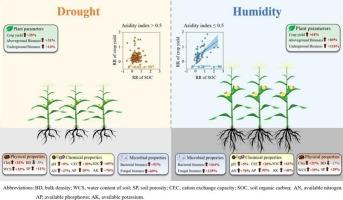修正对沙质土壤作物产量和有机碳的积极影响受干旱调节:一项全球荟萃分析
IF 6.6
1区 农林科学
Q1 SOIL SCIENCE
引用次数: 0
摘要
有机无机改良剂的应用是改善沙质土壤健康,从而提高农业生产力,保障粮食安全的有效管理策略。然而,对改良沙土引起的作物产量变化及其与土壤有机碳(SOC)关系的综合评价却缺乏量化。在此基础上,基于151项野外研究的843个观测数据进行了meta分析,以评估沙质土壤有机和无机修正对作物产量及其与有机碳联系的影响模式和关键控制因素。结果表明,施用改良剂可使沙质土壤的作物产量平均提高39%,有机碳含量平均提高62%,其中复合改良剂增产幅度最大(+ 92%),其次是无机改良剂(+ 62%)和有机改良剂(+ 36%)。无机修正导致土壤有机碳增加最多(+ 133%),其次是复合修正(+ 59%)和有机修正(+ 48%)。作物产量与土壤有机碳的响应具有气候依赖性,在湿润地区呈显著正相关(干旱指数<; 0.5),而在干旱区无显著相关。作物产量响应与年平均气温、土壤改良量、土壤沙粒和有机碳初始含量呈正相关,而与干旱指数、改良期和土壤pH呈正相关。随机森林分析显示,气候(干旱指数)和土壤性质(土壤初始有机碳和pH)是影响作物产量响应的关键因素,两者共同解释了48%的变化。此外,干旱指数通过调节土壤有机碳和养分有效性间接影响作物产量响应。土壤有机碳含量高的湿润地区施用改剂剂的作物增产幅度(50 - 56%)显著高于土壤有机碳含量低的寒冷干旱地区(30 - 35%)。我们的研究结果表明,作物产量对改良剂施用的响应在很大程度上取决于土壤性质和气候,这突出了选址对优先使用适当改良剂的重要性,从而最大限度地提高沙质土壤的肥力和生产力。本文章由计算机程序翻译,如有差异,请以英文原文为准。

Positive effects of amendments on crop yield and organic carbon in sandy soils are regulated by aridity: A global meta-analysis
Organic and inorganic amendment application is regarded as an effective management strategy for improving sandy soil health, thus enhancing agricultural productivity and ensuring food security. However, the comprehensive assessment of changes in crop yield and its association with soil organic carbon (SOC) induced by amendments into sandy soil has been poorly quantified. Herein, a global meta-analysis based on 843 observations from 151 field-based studies was conducted to evaluate the patterns and key controlling factors of crop yield and its linkage with SOC in response to organic and inorganic amendments into sandy soil. Results showed that amendment application strongly increased crop yield by 39 % and SOC by 62 % on average in sandy soils, with the greatest yield increase by composite amendments (+92 %), followed by inorganic amendments (+62 %) and organic amendments (+36 %). The inorganic amendment led to the highest increase in SOC (+133 %), followed by composite (+59 %) and organic amendments (+48 %). The linkage between the responses of crop yield and SOC was climate–dependent, with a strongly positive correlation in humid regions (aridity index < 0.5), while no significant relationship was observed in arid regions. The crop yield response positively correlated with mean annual temperature, amendment amount, and initial contents of soil sand and SOC, but decreased with aridity index, amendment duration and soil pH. Random forest analysis revealed that climate (aridity index) and soil properties (initial SOC and pH) were key factors regulating crop yield response, collectively explaining 48 % of the variation. Moreover, aridity index was the key driver indirectly affecting crop yield response via regulating SOC and nutrient availability. Crop yield increase by amendment application was significantly larger (50–56 %) under humid regions with high SOC relative to cold and arid regions with low SOC (30–35 %). Our findings suggest that crop yield response to amendment application strongly depends on soil properties and climate, highlighting the importance of site choices for prioritizing the use of appropriate amendments, so as to maximize the beneficial strategies for improving the fertility and productivity of sandy soils.
求助全文
通过发布文献求助,成功后即可免费获取论文全文。
去求助
来源期刊

Geoderma
农林科学-土壤科学
CiteScore
11.80
自引率
6.60%
发文量
597
审稿时长
58 days
期刊介绍:
Geoderma - the global journal of soil science - welcomes authors, readers and soil research from all parts of the world, encourages worldwide soil studies, and embraces all aspects of soil science and its associated pedagogy. The journal particularly welcomes interdisciplinary work focusing on dynamic soil processes and functions across space and time.
 求助内容:
求助内容: 应助结果提醒方式:
应助结果提醒方式:


